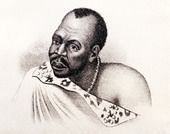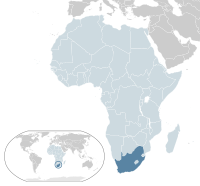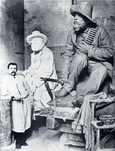Portal:South Africa
Introduction
The Republic of South Africa is a country located at the southern tip of the African continent. It borders the countries of Namibia, Botswana, Zimbabwe, Mozambique, and Eswatini, and entirely surrounds Lesotho.  South Africa has the largest population of people of European descent in Africa, one of the largest Indian population outside of Asia, as well as the largest Coloured (of mixed European, Asian and African descent) community in Africa, making it one of the most ethnically diverse countries on the continent. Racial and ethnic strife between the black majority and the white minority have played a large part in the country's history and politics. The National Party began introducing the policy of apartheid after winning the general election of 1948; however, it was the same party under the leadership of F.W. de Klerk who started to dismantle it in 1990 after a long struggle by the black majority, as well as many white, coloured and Indian South Africans. The country is one of the few in Africa never to have had a coup d'état, and regular free and fair elections have been held since 1994, making it a regional power and among the most stable and liberal democracies in Africa. South Africa is ranked as an upper-middle income economy by the World Bank. It has the second largest economy in Africa after Nigeria, and the 34th-largest in the world. By purchasing power parity, South Africa has the 7th highest per capita income in Africa. Although being the second largest economy, South Africa has the most sophisticated economy in the continent, with modern infrastructure common throughout the country. The country is considered to be a newly industrialized country according to the World Bank classifications. Selected article - Apartheid (/əˈpɑːrt(h)aɪt/ ə-PART-(h)yte, especially South African English: /əˈpɑːrt(h)eɪt/ ə-PART-(h)ayt, Afrikaans: [aˈpartɦɛit] ⓘ; transl. "separateness", lit. 'aparthood') was a system of institutionalised racial segregation that existed in South Africa and South West Africa (now Namibia) from 1948 to the early 1990s. Apartheid was characterised by an authoritarian political culture based on baasskap (lit. 'boss-ship' or 'boss-hood'), which ensured that South Africa was dominated politically, socially, and economically by the nation's minority white population. In this minoritarian system, there was social stratification, where white citizens had the highest status, followed by Indians and Coloureds, then Black Africans. The economic legacy and social effects of apartheid continue to the present day, particularly inequality. Broadly speaking, apartheid was delineated into petty apartheid, which entailed the segregation of public facilities and social events, and grand apartheid, which dictated housing and employment opportunities by race. The first apartheid law was the Prohibition of Mixed Marriages Act, 1949, followed closely by the Immorality Amendment Act of 1950, which made it illegal for most South African citizens to marry or pursue sexual relationships across racial lines. The Population Registration Act, 1950 classified all South Africans into one of four racial groups based on appearance, known ancestry, socioeconomic status, and cultural lifestyle: "Black", "White", "Coloured", and "Indian", the last two of which included several sub-classifications. Places of residence were determined by racial classification. Between 1960 and 1983, 3.5 million black Africans were removed from their homes and forced into segregated neighbourhoods as a result of apartheid legislation, in some of the largest mass evictions in modern history. Most of these targeted removals were intended to restrict the black population to ten designated "tribal homelands", also known as bantustans, four of which became nominally independent states. The government announced that relocated persons would lose their South African citizenship as they were absorbed into the bantustans. (Full article...)Selected picture -On the grounds of the South African National Museum of Military History is the large Anglo-Boer War Memorial designed by Sir Edwin Lutyens. Originally called the Rand Regiments Memorial and dedicated to British soldiers that lost their lives during the Second Boer War, it was rededicated on 10 October 1999 to all people who died during the Second Boer War and renamed the Boer War Memorial. Did you know... -
WikiProjectsThis is a Good article, an article that meets a core set of high editorial standards.
 The mechanics of the running blades used by South African former Paralympic runner Oscar Pistorius depend on special carbon-fiber-reinforced polymer prosthetics. Pistorius has double below-the-knee amputations and competed in both non-disabled and T44 amputee athletics events. Pistorius's eligibility to run in international non-disabled events is sanctioned by the International Association of Athletics Federations (IAAF). Pistorius began running in 2004 after a rugby knee injury which led to rehabilitation at the University of Pretoria's High Performance Centre with coach Ampie Louw. His first racing blades were fitted by South African prosthetist Francois Vanderwatt. Because he was unable to find suitable running blades in Pretoria, Vanderwatt ordered some to be made by a local engineer at Hanger Orthopedic Group. These quickly broke, and Vanderwatt referred Pistorius to American prosthetist and Paralympic sprinter Brian Frasure to be fitted for carbon-fibre blades by Icelandic company Össur. (Full article...)Selected biography -
Anton van Wouw (20 November 1862, Driebergen - 30 July 1945, Pretoria) was a Dutch-born sculptor regarded as the father of South African sculpture.
Van Wouw decided to move to the developing city of Pretoria at the age of 28 and waited for ten years to receive his first commission. This was from financier Sammy Marks to create a monumental statue of Paul Kruger, which stands on Church Square. During his time spent in the wilderness he developed a great admiration for the Boer nation. This also influenced his artistic development a great deal. He identified with the struggles and hopes of these people and this commitment was reflected in his work. A great deal of his work, although representational, captures the rugged and emotional essence of his subjects. One of his most notable pieces of work is the figure of a woman used in the Women’s Monument near Bloemfontein. He collaborated on this with the architect Frans Soff. He was also responsible for the less successful figure of a woman incorporated into the Voortrekker Monument near Pretoria, a powerful bust of General Christiaan de Wet and the statue of Louis Botha in Durban. He also portrayed indigenous peoples and among these smaller sculptures some of his finest work can be found. They are much less formal than his larger work and are appealing in their vivid and lifelike facial expressions. Selected fare or cuisine -
A Hertzoggie /hɜːrtsɒxi/, also known in Afrikaans as a Hertzogkoekie or in English as a Hertzog cookie, is a jam-filled tartlet or cookie with a coconut topping commonly served on a cup-like pastry base. (Full article...)
Selected quote -Selected panorama -Johannesburg CBD at sunrise.
General images -The following are images from various South Africa-related articles on Wikipedia.
TopicsCategoriesRelated portalsRecognized contentNew articlesThis list was generated from these rules. Questions and feedback are always welcome! The search is being run daily with the most recent ~14 days of results. Note: Some articles may not be relevant to this project.
Rules | Match log | Results page (for watching) | Last updated: 2024-05-15 21:45 (UTC) Note: The list display can now be customized by each user. See List display personalization for details.
Associated WikimediaThe following Wikimedia Foundation sister projects provide more on this subject:
Discover Wikipedia using portals | ||||||||
















































































